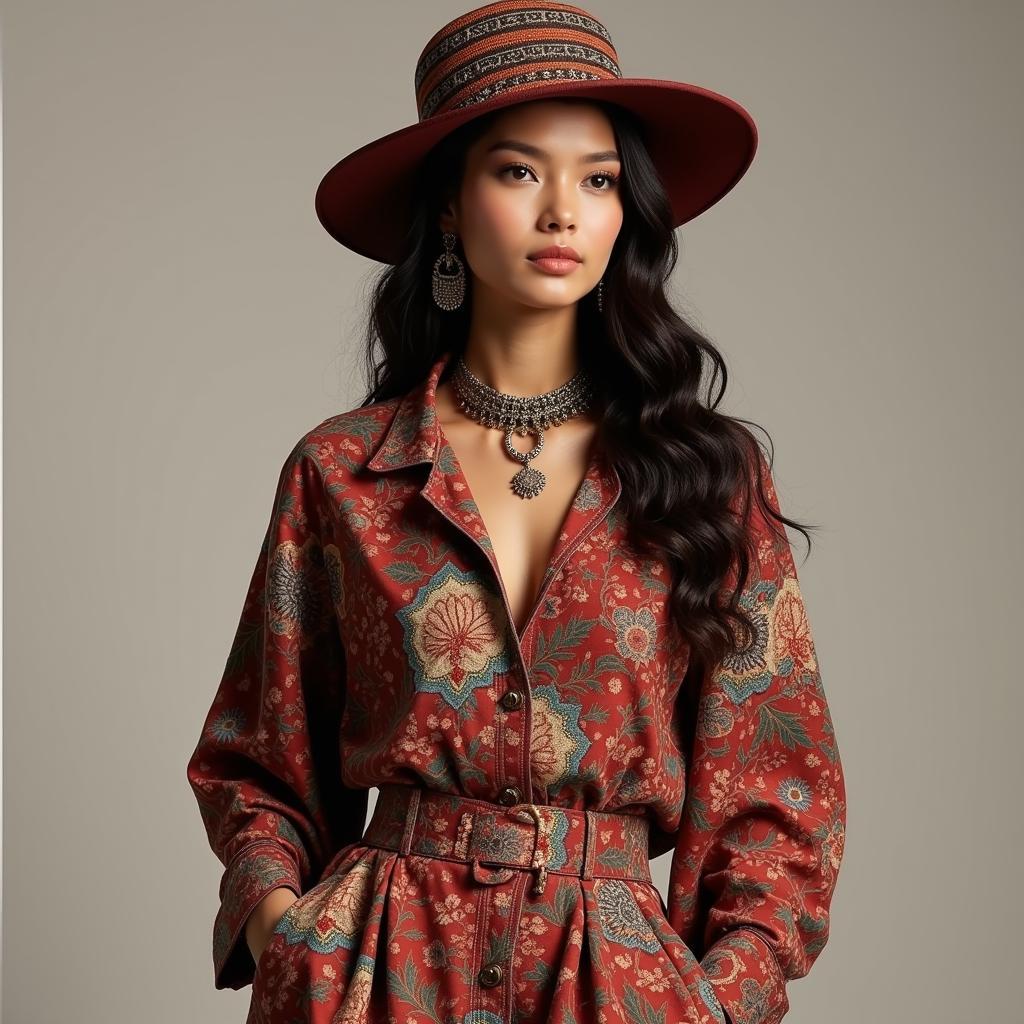Exploring the World of Ethnic Hats
November 4, 2024Ethnic Hats are more than just head coverings; they are vibrant symbols of culture, heritage, and tradition. They tell stories of communities, beliefs, and artistry, passed down through generations. From the intricate beadwork of a Native American headdress to the elegant lines of a Vietnamese nón lá, each hat offers a glimpse into a unique world. This journey into the realm of ethnic hats will uncover their fascinating history, diverse designs, and the cultural significance they hold. We’ll explore how these headpieces have evolved over time, adapting to changing social landscapes while preserving their core identities.
What makes ethnic hats so captivating is their ability to transcend mere functionality. They are often imbued with deep symbolic meaning, representing social status, marital status, or even spiritual beliefs. A brightly colored Andean chullo, for example, not only protects from the harsh mountain climate but also signifies the wearer’s connection to their indigenous roots. Similarly, the conical Asian hat, seen in various forms across the continent, represents protection from the elements and often carries agricultural significance. These hats are not simply accessories; they are statements of identity, woven into the fabric of cultural expression.
The Cultural Significance of Ethnic Hats
Ethnic hats often play a pivotal role in traditional ceremonies and rituals. In many cultures, specific headwear is reserved for special occasions, marking important life events such as weddings, funerals, or religious festivals. These hats become integral parts of the ceremonies, adding a layer of solemnity and tradition to the proceedings.
For instance, the elaborate headdresses worn by some indigenous tribes during ceremonial dances are not merely decorative; they are imbued with spiritual meaning, connecting the wearer to the ancestral spirits and the natural world. The intricate details and symbolism woven into these hats reflect the deep-seated beliefs and values of the community.
Understanding the Symbolism Behind Different Styles
The symbolism of ethnic hats can be complex and multifaceted, varying significantly across cultures. While some hats denote status and power, others represent humility and respect. Understanding the nuances of these symbolic meanings requires careful consideration of the cultural context and historical background.
The fez, a brimless hat once popular in parts of the Ottoman Empire, serves as an excellent example. Originally adopted as a symbol of modernization, the fez eventually became associated with political and social changes, reflecting the complex interplay between tradition and progress.
Ethnic Hats Around the World
Exploring the diversity of ethnic hats across the globe reveals a stunning array of styles, materials, and techniques. Each region boasts its own unique headwear traditions, reflecting the local environment, cultural practices, and artistic sensibilities.
From the wide-brimmed sombreros of Mexico to the intricate turbans of the Middle East, the world of ethnic hats is a testament to human creativity and adaptability. These headpieces, shaped by climate, culture, and history, provide a fascinating window into the diverse tapestry of human experience.
Preserving Tradition Through Craftsmanship
Many ethnic hats are crafted using traditional techniques passed down through generations. These skills, often involving intricate weaving, embroidery, or beadwork, represent a vital link to the past. Preserving these craft traditions is essential for maintaining cultural heritage and ensuring that the stories embedded in these headpieces continue to be told. personalized reborn dolls can also be seen as a form of artistic expression, reflecting a desire to capture and preserve a moment in time.
Ethnic Hats in Modern Fashion
While rooted in tradition, ethnic hats are not confined to the past. They are increasingly finding their way into modern fashion, adding a touch of cultural flair to contemporary styles. This resurgence of interest in ethnic headwear reflects a growing appreciation for cultural diversity and a desire to connect with global traditions. Designers are incorporating elements of traditional hat designs into their collections, creating unique and stylish pieces that celebrate cultural heritage.
 Ethnic Hats in Modern Fashion
Ethnic Hats in Modern Fashion
Styling Tips for Incorporating Ethnic Hats into Your Wardrobe
Incorporating ethnic hats into your wardrobe can be a fun and expressive way to showcase your personal style. However, it’s important to do so respectfully, acknowledging the cultural significance of these headpieces. When choosing an ethnic hat, consider the context and occasion. A brightly colored, patterned hat might be perfect for a festival or a summer outing, while a more subdued design might be appropriate for a more formal setting.
Conclusion
Ethnic hats are a powerful expression of cultural identity, reflecting the history, traditions, and artistry of communities around the world. From their symbolic meanings to their diverse designs, these headpieces offer a fascinating glimpse into the rich tapestry of human culture. By understanding and appreciating the significance of ethnic hats, we can celebrate the diversity of our global heritage. personalized reborn dolls and ethnic hats both offer unique ways to express personal style and connect with different cultures.
FAQ
- What are some of the most iconic ethnic hats?
- How can I incorporate ethnic hats into my wardrobe respectfully?
- What materials are commonly used to make ethnic hats?
- Are there any specific care instructions for ethnic hats?
- Where can I find authentic ethnic hats?
- What is the cultural significance of wearing a specific ethnic hat?
- How do ethnic hats reflect the environment and lifestyle of a community?
When you need assistance, please contact us at Phone Number: 0963418788, Email: [email protected] Or visit us at: 2M4H+PMH, Nghĩa Thành Ward, Gia Nghĩa, Đắk Nông, Vietnam. We have a 24/7 customer service team.